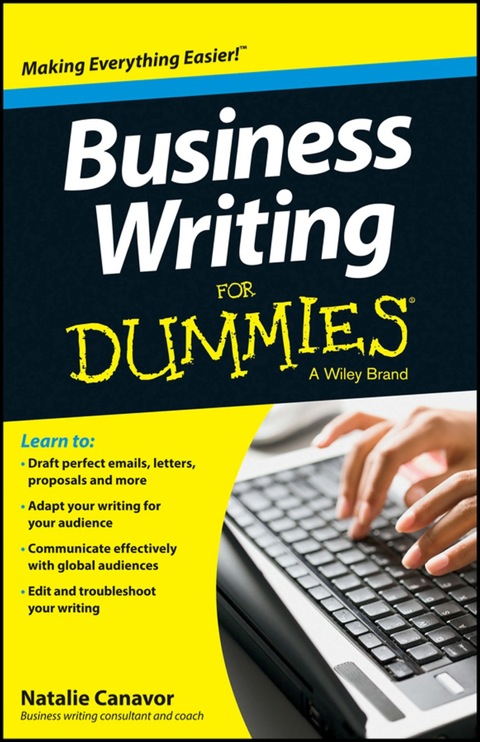Description
Efnisyfirlit
- Contents at a Glance
- Table of Contents
- Introduction
- Conventions Used in This Book
- What You Need Not Read
- Foolish Assumptions
- How This Book Is Organized
- Icons Used in This Book
- Where to Go From Here
- Part I: Winning with Writing
- Chapter 1: Make Writing Your Not-So-Secret Weapon
- Planning and Structuring Every Message
- Applying Audience-Plus-Goal Strategy to Any Business Need
- Chapter 2: Planning Your Message: Your Secret Weapon
- Adopting the Plan-Draft-Edit Principle
- Fine-Tuning Your Plan: Your Goals and Audience
- Making People Care
- Choosing Your Written Voice: Tone
- Using Relationship-Building Techniques
- Chapter 3: Making Your Writing Work: The Basics
- Stepping into 21st-Century Writing Style
- Enlivening Your Language
- Using Reader-Friendly Graphic Techniques
- Chapter 4: Self-Editing: Professional Ways to Improve Your Own Work
- Changing Hats: Going from Writer to Editor
- Reviewing the Big and Small Pictures
- Moving from Passive to Active
- Sidestepping Jargon, Clichés and Extra Modifiers
- Chapter 5: Troubleshooting Your Writing: Fixing Common Problems
- Organizing Your Document
- Catching Common Mistakes
- Reviewing and Proofreading: The Final Check
- Part II: Putting Your Skills to Work for Everyday Business Writing
- Chapter 6: Writing Emails That Get Results
- Fast-Forwarding Your Agenda In-House and Out-of-House
- Getting Off to a Great Start
- Building Messages That Achieve Your Goals
- Structuring Your Middle Ground
- Closing Strong
- Perfecting Your Writing for Email
- Chapter 7: Creating High Impact Business Correspondence
- Succeeding with Cover Letters
- Networking with Letters
- Writing to Complain
- Crafting Letters of Record
- Introducing Yourself in Letter Form
- Creating Sales Letters
- Part III: Writing Business Documents, Promotional Material and Presentations
- Chapter 8: Building the Biggies: Major Business Documents
- Writing the Executive Summary
- Shaping Successful Reports
- Fast-tracking yourself through Proposals
- Creating Business Plans
- Writing Tips for All Business Documents
- Chapter 9: Promoting Yourself and Your Organization
- Finding the Heart of Your Business Message
- Finding, Shaping and Using Stories
- Using Value Messages and Stories to Promote
- Chapter 10: Writing for the Spoken Word
- Elevating Your Elevator Speech
- Preparing and Giving Presentations
- Scripting for Video
- Scripting Yourself for Practical Purposes
- Part IV: Writing for the Digital Universe
- Chapter 11: Evolving Your Writing for Online Media
- Gaining Perspective on Digital Media
- Strategizing Your Digital Media Program
- Turning Scanners into Readers
- Shaping Your Writing for Digital Media
- Chapter 12: Writing for Websites and Blogs
- Shaping Your Words for Websites and Blogs
- Building a Traditional Website
- Incorporating Graphics and Other Elements
- Creating Your Own Blog
- Part V: Thinking Global, Writing Global
- Chapter 13: Using English as the Global Language of Business
- Considering Native English in All Its Flavors
- Adapting Your Writing for Global English
- Writing Messages to Send ‘Round the World’
- Writing Other Materials
- Chapter 14: Adapting Business English to Specific Countries
- Writing to China
- Writing to Russia
- Writing to France
- Writing to Japan
- Writing to India
- Writing to Mexico
- Writing to Germany
- Writing to Brazil
- Part VI: The Part of Tens
- Chapter 15: Ten Ways to Advance Your Career with Writing
- Use Everything You Write to Build Your Professional Image
- Write a Great Elevator Speech – and Use It
- Write a Long-Range Career Plan for Yourself
- Write an Ad for Your Dream Job
- Go Out of Your Way to Thank People
- Take Notes to Control the Conversation
- Use Messages to Stay in Touch and Build Relationships
- Write First-Rate Blog Posts, Comments and Tweets
- Know How to Explain Your Value
- Profile Your Supervisor for a Better Relationship
- Chapter 16: Ten Ways to Tweet Strategically
- Plan Your Twitter Program
- Decide Who You Want to Be
- Take Pains with Your Bio and Photo
- Listen to Your Target Audiences
- Aim to Be Useful
- Avoid Blatant Self-Promotion
- Use Twitter for Surveys and Questions
- Write Tweets as the Ultimate Self-Edit Test
- Tweet at Optimal Times
- Treat Twitter as a Serious Job-Hunting Tool
- Index
- About the Author






Reviews
There are no reviews yet.